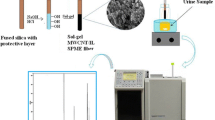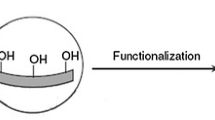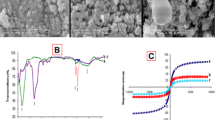Abstract
Direct immersion solid-phase microextraction (DI-SPME) is an effective microsampling strategy for polar and ionic species in aqueous media. Nevertheless, the fiber coating is in direct contact with sample solution and affected by its conditions. To compensate this limitation and to improve the extraction efficiency, a magnetic fiber coating was prepared and employed for DI-SPME sampling under the enhancing effect of a magnetic field. Magnetic iron oxide core–shell silica nanoparticles were synthesized and embedded in polypyrrole using an in situ electropolymerization method along with simultaneous coating on the surface of a platinized stainless-steel fiber. It was then applied for magnetic-assisted DI-SPME (MA-DI-SPME) sampling of endogenous aldehydes in human urine. Sample solution pH, the magnetic field intensity, ionic strength and extraction time were evaluated as the important affecting variables. Limits of detection were obtained 0.01–0.1 ng mL−1; the calibration graphs were linear over the range of 0.1–10000 ng mL−1. The inter-fiber (fiber-to-fiber) reproducibility was found to be 10.7–12.5%. Matrix effect from urine samples was not observed at concentration levels of 0.2, 2, and 8 µg mL−1. The results showed that magnetic field increased the efficiency of DI-SPME method about two to four times. The developed strategy was successfully applied for the extraction and quantification of hexanal and heptanal (as the most important aldehyde biomarkers) in urine samples.
Graphical Abstract





Similar content being viewed by others
References
Armenta S, Garrigues S, de la Guardia M (2015) The role of green extraction techniques in green analytical chemistry. Trends Anal Chem 71:2–8. https://doi.org/10.1016/j.trac.2014.12.011
Song D, Gu Y, Liang L, Ai Z, Zhang L, Xu H (2011) Magnetic solid-phase extraction followed by high performance liquid chromatography for determination of hexanal and heptanal in human urine. Anal Methods 3:1418–1423. https://doi.org/10.1039/C1AY05102D
Spietelun A, Marcinkowski Ł, de la Guardia M, Namieśnik J (2014) Green aspects, developments and perspectives of liquid phase microextraction techniques. Talanta 119:34–45. https://doi.org/10.1016/j.talanta.2013.10.050
Ghiasvand A, Dowlatshah S, Nouraei N, Heidari N, Yazdankhah F (2015) A solid-phase microextraction platinized stainless steel fiber coated with a multiwalled carbon nanotube-polyaniline nanocomposite film for the extraction of thymol and carvacrol in medicinal plants and honey. J Chromatogr A 1406:87–93. https://doi.org/10.1016/j.chroma.2015.06.052
Ghiasvand AR, Hosseinzadeh S, Pawliszyn J (2006) New cold-fiber headspace solid-phase microextraction device for quantitative extraction of polycyclic aromatic hydrocarbons in sediment. J Chromatogr A 1124:35–42. https://doi.org/10.1016/j.chroma.2006.04.088
Zhang Z, Pawliszyn J (1993) Headspace solid-phase microextraction. Anal Chem 65:1843–1852. https://doi.org/10.1021/ac00062a008
Ghiasvand AR, Hajipour S (2016) Direct determination of acrylamide in potato chips by using headspace solid-phase microextraction coupled with gas chromatography-flame ionization detection. Talanta 146:417–422. https://doi.org/10.1016/j.talanta.2015.09.004
Ghiasvand AR, Hajipour S, Heidari N (2016) Cooling-assisted microextraction: comparison of techniques and applications. Trends Anal Chem 77:54–65. https://doi.org/10.1016/j.trac.2015.12.008
Risticevic S, Lord H, Górecki T, Arthur CL, Pawliszyn J (2010) Protocol for solid-phase microextraction method development. Nat Protoc 5:122–139. https://doi.org/10.1038/nprot.2009.179
Djozan D, Baheri T, Pournaghi-Azar M (2007) Development of electro solid-phase microextraction and application to methamphetamine analysis. Chromatographia 65:45–50. https://doi.org/10.1365/s10337-006-0127-0
Rezazadeh M, Yamini Y, Seidi S, Ebrahimpour B (2013) Electromembrane surrounded solid phase microextraction: A novel approach for efficient extraction from complicated matrices. J Chromatogr A 1280:16–22. https://doi.org/10.1016/j.chroma.2013.01.034
Alsharaa A, Basheer C, Amayreh M, Sajid M (2016) Flow-assisted electroenhanced solid-phase microextraction for the determination of haloethers in water samples. Chromatographia 79:97–102. https://doi.org/10.1007/s10337-015-3003-y
Moliner-Martínez Y, Prima-Garcia H, Ribera A, Coronado E, Campins-Falco P (2012) Magnetic in-tube solid phase microextraction. Anal Chem 84:7233–7240. https://doi.org/10.1021/ac301660k
Mei M, Huang X, Luo Q, Yuan D (2016) Magnetism-enhanced monolith-based in-tube solid phase microextraction. Anal Chem 88:1900–1907. https://doi.org/10.1021/acs.analchem.5b04328
González-Fuenzalida R, Moliner-Martínez Y, Prima-Garcia H, Ribera A, Campins-Falcó P, Zaragozá R (2014) Evaluation of superparamagnetic silica nanoparticles for extraction of triazines in magnetic in-tube solid phase microextraction coupled to capillary liquid chromatography. Nanomaterials 4:242–255. https://doi.org/10.3390/nano4020242
Moliner-Martinez Y, Vitta Y, Prima-Garcia H, González-Fuenzalida RA, Ribera A, Campíns-Falcó P, Coronado E (2014) Silica supported Fe3O4 magnetic nanoparticles for magnetic solid-phase extraction and magnetic in-tube solid-phase microextraction: application to organophosphorous compounds. Anal Bioanal Chem 406:2211–2215. https://doi.org/10.1007/s00216-013-7379-y
Manbohi A, Ahmadi SH (2015) In-tube magnetic solid phase microextraction of some fluoroquinolones based on the use of sodium dodecyl sulfate coated Fe3O4 nanoparticles packed tube. Anal Chim Acta 885:114–121. https://doi.org/10.1016/j.aca.2015.05.030
Antón AP, Ferreira AMC, Pinto CG, Cordero BM, Pavón JLP (2014) Headspace generation coupled to gas chromatography–mass spectrometry for the automated determination and quantification of endogenous compounds in urine. Aldehydes as possible markers of oxidative stress. J Chromatogr A 1367:9–15. https://doi.org/10.1016/j.chroma.2014.09.038
Ghiasvand A, Heidari N, Abdolhosseini S (2018) Iron oxide/silica/polypyrrole nanocomposite sorbent for the comparison study of direct-immersion and headspace solid-phase microextraction of aldehyde biomarkers in human urine. J Pharm Biomed Anal 159:37–44. https://doi.org/10.1016/j.jpba.2018.06.052
Zhang M, Li S, Yu C, Liu G, Jia J, Lu C, He J, Ma Y, Zhu J, Yu C (2010) Determination of melamine and cyanuric acid in human urine by a liquid chromatography tandem mass spectrometry. J Chromatogr B 878:758–762. https://doi.org/10.1016/j.jchromb.2010.01.020
Naccarato A, Tassone A, Moretti S, Elliani R, Sprovieri F, Pirrone N, Tagarelli A (2018) A green approach for organophosphate ester determination in airborne particulate matter: microwave-assisted extraction using hydroalcoholic mixture coupled with solid-phase microextraction gas chromatography-tandem mass spectrometry. Talanta 189:657–665. https://doi.org/10.1016/j.talanta.2018.07.077
Lord H, Pawliszyn J (2000) Microextraction of drugs. J Chromatogr A 902:17–63. https://doi.org/10.1016/S0021-9673(00)00836-0
Lambropoulou DA, Albanis TA (2001) Optimization of headspace solid-phase microextraction conditions for the determination of organophosphorus insecticides in natural waters. J Chromatogr A 922:243–255. https://doi.org/10.1016/S0021-9673(01)00953-0
Liu F, Xu H (2017) Development of a novel polystyrene/metal-organic framework-199 electrospun nanofiber adsorbent for thin film microextraction of aldehydes in human urine. Talanta 162:261–267. https://doi.org/10.1016/j.talanta.2016.09.065
Wang Q, O’Reilly J, Pawliszyn J (2005) Determination of low-molecular mass aldehydes by automated headspace solid-phase microextraction with in-fibre derivatisation. J Chromatogr A 1071:147–154. https://doi.org/10.1016/j.chroma.2004.09.031
Ramezani Z, Mirzajani R, Kardani F (2015) A novel ultrasound-assisted back extraction reverse micelles method coupled with gas chromatography-flame ionization detection for determination of aldehydes in heated edibles oils. Food Chem 188:30–36. https://doi.org/10.1016/j.foodchem.2015.04.112
Li N, Deng C, Yao N, Shen X, Zhang X (2005) Determination of acetone, hexanal and heptanal in blood samples by derivatization with pentafluorobenzyl hydroxylamine followed by headspace single-drop microextraction and gas chromatography–mass spectrometry. Anal Chim Acta 540:317–323. https://doi.org/10.1016/j.aca.2005.03.047
Liu J-F, Yuan B-F, Feng Y-Q (2015) Determination of hexanal and heptanal in human urine using magnetic solid phase extraction coupled with in-situ derivatization by high performance liquid chromatography. Talanta 136:54–59. https://doi.org/10.1016/j.talanta.2015.01.003
Chen F, Wang C, Zhang M, Zhang X, Liu Y, Ye J, Chu Q (2014) Sensitive determination of endogenous hexanal and heptanal in urine by hollow-fiber liquid-phase microextraction prior to capillary electrophoresis with amperometric detection. Talanta 119:83–89. https://doi.org/10.1016/j.talanta.2013.10.052
Acknowledgements
The authors are grateful to Mr. Givekesh and Mr. Torabi (Electronic Technicians) for their constructive helps for fabrication of the electromagnet. The authors also sincerely acknowledge Sina Pathobiology Laboratory for providing urine samples.
Funding
This study was not funded by any grants.
Author information
Authors and Affiliations
Corresponding author
Ethics declarations
Conflict of Interest
The authors have no conflict of interest to declare.
Ethical Approval
This article does not contain any studies with human participants or animals performed by any of the authors.
Electronic supplementary material
Below is the link to the electronic supplementary material.
Rights and permissions
About this article
Cite this article
Ghiasvand, A., Heidari, N. & Abdolhosseini, S. Magnetic Field-Assisted Direct Immersion SPME of Endogenous Aldehydes in Human Urine. Chromatographia 81, 1579–1587 (2018). https://doi.org/10.1007/s10337-018-3620-3
Received:
Revised:
Accepted:
Published:
Issue Date:
DOI: https://doi.org/10.1007/s10337-018-3620-3




